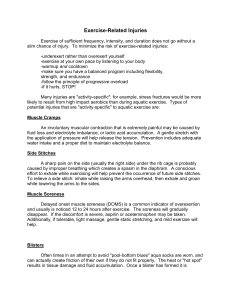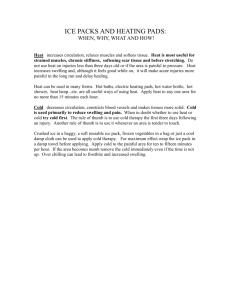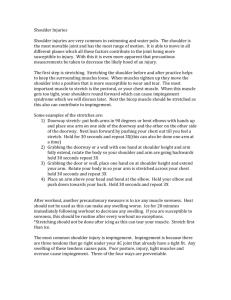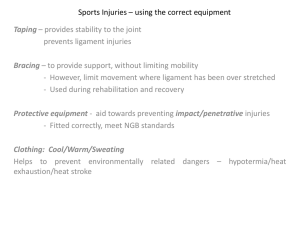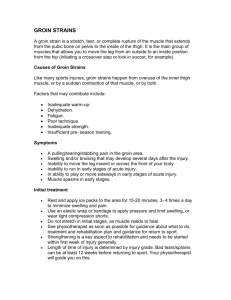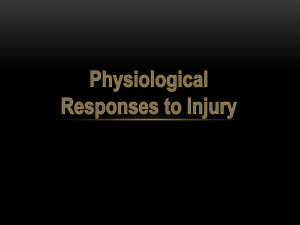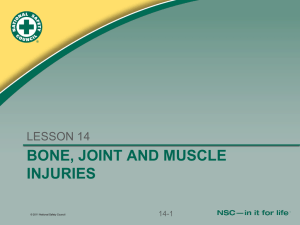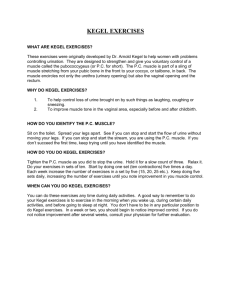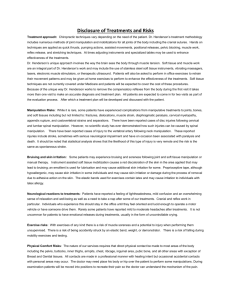File - PE Course Specification
advertisement
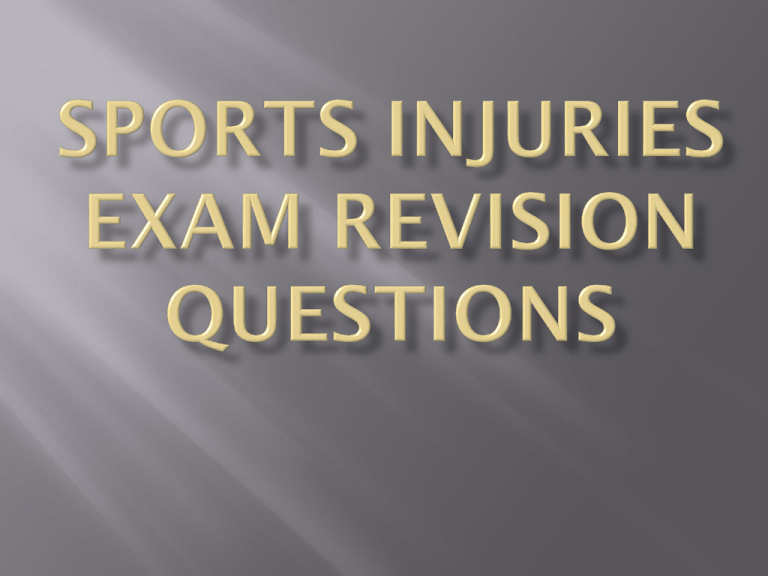
a) b) RICE Rest – stop the activity as soon as the injury occurs to prevent making it any worse. Ice – applied to injured area for 10-15 mins then taken away for 20 mins (and repeat). Reduces internal bleeding and swelling. Compression – Reduces swelling and so speeds recovery. Elevation – elevate injured area above heart. Reduces swelling and inflammation. Cryotherapy – the use of cold temperatures (e.g. cryogenic chambers) Hyperbaric chambers / oxygen tents Hypoxic tents (simulating high altitude to promote red blood cell production). a) b) 5-10 min light cardiovascular activity to raise body temperature and enhance elasticity of muscles, tendons, ligaments and joint structures. Range of dynamic exercises to addressing key major muscle groups. Ensure that exercises are sports specific. Gradual increasing of intensity. Light cardiovascular activity to prevent blood pooling and to deal with excess muscle lactic acid. Static stretching to help muscles and tendons relax, stopping them becoming tight. Warm-down helps prevent delayed onset muscle soreness (DOMS). a) b) c) The general or local use of cold temperatures in the treatment of injury. Ice baths and cryogenic chambers are often used as part of post-match recovery. Stops internal bleeding to reduce swelling and aid recovery. A series of exercises aimed at rebuilding the performer’s proprioceptive sense. Proprioception is the body’s awareness of position, movement and changes in state of balance. This information comes from proprioceptors in joints, tendons and muscles as well as visual and auditory senses. Retraining activities include hopping on a trampette, balance board exercises etc. Application of massage techniques to the muscle and connective tissues to enhance sports performance. Used to increase range of movement / flexibility and to relieve muscle soreness. May help injury prevention and promote faster recovery. Research of its benefits is inconclusive. Must name a sport. Ensure that correct protective equipment is worn/used (make specific to the sport). Ensure that appropriate footwear is worn. Use taping and bracing to support weak areas of the body. Ensure that the body is fully conditioned to take part in the sport (link to specific sport). Core strength training to provide the body with stability and reduce chance of injury (esp lower back). Strengthening muscles to prevent repetitive strain injuries. Ensure that adequate rest is allowed during training to avoid the risks associated with overtraining. Ensure that diet is appropriate for performers training level. Ensure that an appropriate warm-up is undertaken prior to the event including a cardiovascular pulse-raiser and a series of dynamic exercises and stretches. A. Reduces pressure at injured area/reduces swelling B. (Chamber) delivers oxygen at high pressure C. Approximately 2.5 more times than normal/100% pure oxygen D. Haemoglobin/red blood cells fully saturated with oxygen E. Excess oxygen dissolved in plasma F. Oxygen reaches parts of body that not normally saturated G. Increased white blood cell activity at injury site H. Increased blood supply/formation of new blood cells A. Active warm-up/Active warm-down/cool down/stretching B. Avoid eccentric contractions early in session C. Gradually increase intensity of workload D. Massage E. Ice baths A. (Involves sitting in ice cold water for) between 5 – 20 minutes B. Causes blood vessels to tighten/decreases metabolic activity/vasoconstriction C. Restricting blood flow to the area D. Reduces swelling/tissue breakdown/aids muscle repair E. After leaving the ice bath, area is flooded with new blood/vasodilation F. Fresh oxygen removes lactic acid (when out of the ice bath) G. Some studies suggest ice baths of limited value Symptoms: Deep muscle soreness Nagging injury Difficulty in training hard enough to reach desired heart rate level Loss of apetite Recurring sore throat etc as a result of depressed immune system Sleeping problems Ways to avoid overtraining: Allow sufficient recovery time Restrore glycogen stores after hard sessions Never train when ill Build up training loads gradually (especially after illness/injury Use meditation and relaxation methods to improve sleep Ensure that diet is nutritionally balanced Long term athlete development programme – a generic strategy for the development of performers from the nursery to the podium. FUNdamentals (5-11 yrs) Focus is on fun in every session Participation in wide range of sports Development of fundamental motor skills – running, jumping, kicking, catching, striking etc. Development of ABC (agility, balance, coordination) Low level training for speed and endurance through fun games Introduction of simple rules Strength training using own bodyweight. Learning to Train (8-12) Further development of fundamental motor skills Learning general overall sports skills Continuing to develop strength using bodyweight, medicine balls etc Developing endurance with games and relays Introducing basic flexibility exercises Developing speed during warm-up activities Developing knowledge of warm up, cool down, stretching, hydration, nutrition. 70-30 training-competition ratio.
